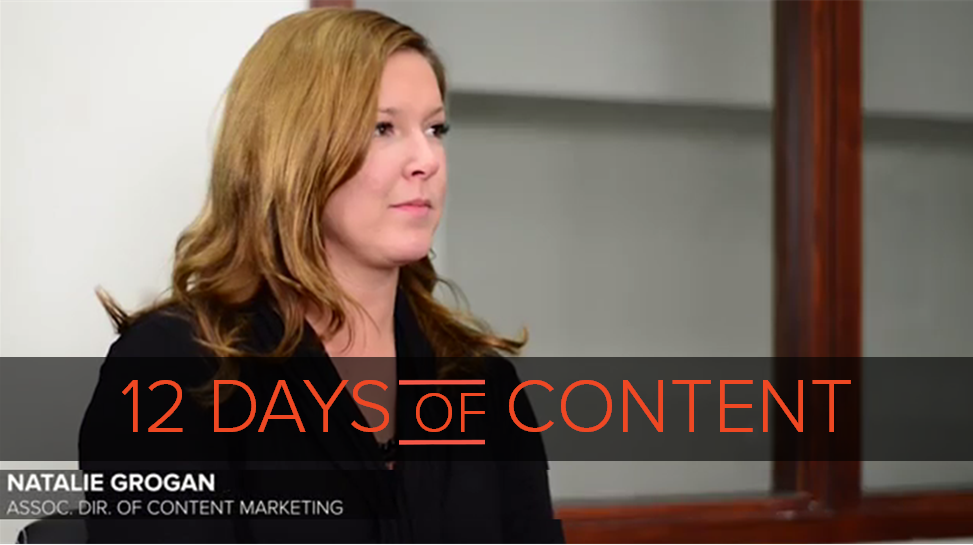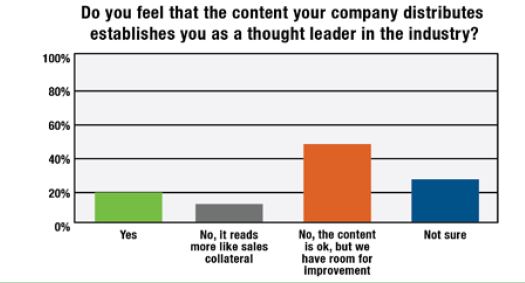Thought leadership is a buzzword in web marketing. It’s also something most marketers strive for when they invest in content marketing – but not everyone achieves it. The reason why this goal is so elusive is that thought leadership can’t be taken or assumed by a company that wants it – it has to be given by others. That is, people have to recognize your brand as a thought leader. You can’t just claim to be one.
For the eighth day of our 12 Days of Content series, we asked Associate Director of Content Marketing Natalie Grogan to explain what formats promote thought leadership, and how to measure whether the campaign is gaining traction. Watch her interview and read on for additional insights about content for thought leadership.
According to the IMN 2014 Content Marketing survey, 20 percent of marketers think they’re successfully becoming thought leaders. However, the majority report there’s still room for improvement. About 15 percent say their content reads more like sales collateral, and 50 percent think their content is doing OK but could be doing more to show off their expertise.
Here are some tips for making content marketing that supports your goal of becoming a thought leader:
Define what thought leadership means to you
Part of the reason why thought leadership is so slippery a goal is that it’s hard to define. To one business, thought leadership may mean being recognized as an industry leader for innovating ideas ahead of competitors. To another, it could be recognition as a dependable source of information.
According to Natalie, “‘Thought Leadership’ is a trendy marketing buzz phrase that’s often used without considering what it actually means. It’s first important that you and your team agree upon how you define it. I define thought leadership as answering questions or solving problems that your audience has with a fresh, unique perspective.”
Once you know what it means to your brand, you can start to identify which content formats will best serve your goal of becoming a thought leader.
Create expert content that’s authoritative and useful
When you think about thought leadership, you need to stop thinking about a rigid, long-form document that’s chock full of stats and formal language (unless that’s what your audience really wants). What you should start thinking about is how you can take the same information you’d put into that document, and insert it into a format that’s more accessible to readers, such as:
- An illustratived eBook
- An informative infographic
- A video interview with experts
“If I can provide one piece of advice on creating thought leadership content, it’s to keep it simple. Smart and approachable is the way to go so that your audience feels comfortable interacting with you and trusts the information you’re sharing,” said Natalie.
It’s what you say AND how you say it – and that doesn’t mean to use industry jargon or smart-sound technical terms. It means demonstrating your authority on the topic by spelling it out in the simplest terms possible.
Google’s Search Master Matt Cutts has come out and said that it’s in publishers’ best interest to create content that explains things simple to web readers, reiterating that those who understand topics the best can relay them in the most basic terms.
It’s what you say AND how you say it – and that doesn’t mean to use industry jargon or smart-sound technical terms.
And when you’re writing thought leadership pieces, use your personal experience, Natalie suggests. “That’s part of what shows that you’re the expert. The whole point is a new perspective so don’t be afraid to suggest something new or even controversial to an extent. Insert your opinions because that’s the only way you’ll truly stand out.”
Measure your repeat traffic, social signals and lead generation
Once you have content that shows off your expertise, you need to have a reliable way to measure the impact it’s having on your bottom line. Here are some of the content analytics metrics you can use to track whether you’re becoming a thought leader.
- Repeat traffic
More repeat traffic means people are coming back to your site because they find the information you’re sharing valuable
- Inbound links
Google and other search engines use inbound links to rank content because it’s seen as a measure of trust and authority. When other sites link to your content, they’re giving you a stamp of approval that denotes what you’re saying is valuable and trustworthy. Look for more inbound links as a measure of thought leadership.
- Form fills and leads
If users are downloading your gated resources, like white papers, eBooks and infographics, it indicates that they trust you and are willing to give you something in return for their insights.
- Social interactions
An influx of Twitter or LinkedIn followers indicates people think you’re worth listening to. Look for engagement from other influencers as a signal that you’re making an impact on the existing leaders in the space and building a positive reputation with your audience.
Stop selling, start sharing
The point of thought leadership is to share some of your insights with prospects as a way to gain their trust and respect. Some people think about it as giving away free samples of your services, as a taste of what customers get when they buy from you. To become a thought leader, you first have to be willing to share those insights, but the risk is worth the reward.
When you are recognized as a valuable source of information, you’ll become more recognizable and influential in your field.
To learn more about thought leadership:
- Get in touch with a member of our team
- Review this resource: Can content make you a thought leader?
- Check out this blog about creating Long-form content for thought leadership & traffic wins




